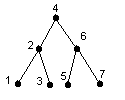| ENG RUS | Timus Online Judge |
USU Junior Contest October'2001
Contest is over
B. HierarchyTime limit: 1.0 second Memory limit: 64 MB  During long years of work in SKB Kontur a certain hierarchy of employees has been developed. Each person except ordinary employees has exactly two direct subordinates and not more than one direct superior. There is no subordinate of ordinary employees (see figure). Each employee has his own number. Of course, different employees have different numbers. It's known as well that either an employee has the maximal number or there is another employee whose number is greater by one. Similarly, either
an employee has a number "1" or there is another employee whose number is less by one. The number of intermediate levels of employees between an arbitrary employee who has subordinates (an ordinary employee) and the employee who has no superiors (the main superior) is the same for all ordinary employees.
The things have come round so that each employee who has subordinates
has got a number greater than the number of one of his subordinates and less than the number of the other. Moreover, if his number is greater than his superior's
then the numbers of his subordinates are also greater than the number
of his superior. And conversely, if his number is less, then his subordinates'
numbers are less too.
A special system of intracorporate message exchange has been worked out. A message from an
employee with the number i can be addressed directly only to
the employees i-1 and i+1. Moreover, this is done the same day
(it takes 0 days to do that) if the employees are direct superior and
subordinate. Otherwise, the message delivery takes an amount of days that
is equal to the number of intermediate employees between the sender and recipient. For example, a message from the employee 2 to
the employee 4 is being delivered as follows. The employee 2 sends the
message to the employee 3, and the employee 3 addresses it to the employee 4.
This process takes one day because the first step (2->3) takes 0 days,
and the second one (3->4) takes 1 day. InputThe only line contains two positive integers: the number of an employee who sends a message and the number of the recipient. Each of the numbers doesn't exceed 231−1. OutputYou should output the only number — the number of days necessary
to deliver the message. Sample
Problem Author: Alexander Somov Problem Source: USU Open Collegiate Programming Contest October'2001 Junior Session |
